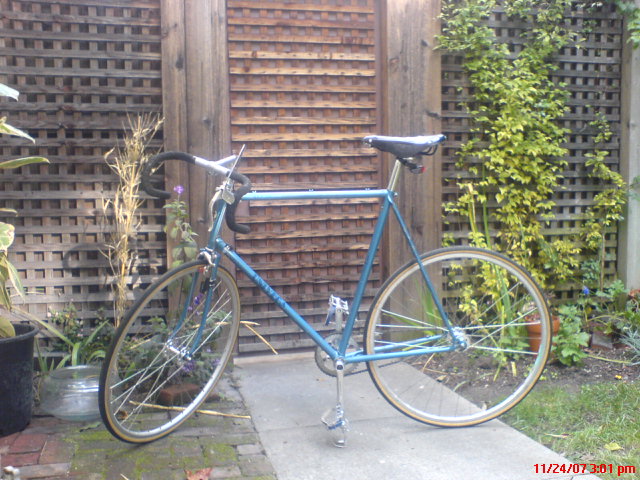tecznotes
Michal Migurski's notebook, listening post, and soapbox. Subscribe to ![]() this blog.
Check out the rest of my site as well.
this blog.
Check out the rest of my site as well.
Mar 17, 2014 12:49am
managers are awesome / managers are cool when they’re part of your team
Apropos the Julie Ann Horvath Github shitshow, I’ve been thinking this weekend about management, generally.
I don’t know details about the particular Github situation so I won’t say much about it, but I was present for Tom Preston-Werner’s 2013 OSCON talk about Github. After a strong core message about open source licenses, liability, and freedom (tl;dr: avoid the WTFPL), Tom talked a bit about Github’s management model.
Management is about subjugation; it’s about control.
At Github, Tom described a setup where the power structure of the company is defined by the social structures of the employees. He showed a network hairball to illustrate his point, said that Github employees can work on what they feel like, subject to the strategic direction set for the company. There are no managers.
This bothered me a bit when I heard it last summer, and it’s gotten increasingly more uncomfortable since. I’ve been paraphrasing this part of the talk as “management is a form of workplace violence,” and the still-evolving story of Julie Ann Horvath suggests that the removal of one form of workplace violence has resulted in the reintroduction of another, much worse form. In my first post-college job, I was blessed with an awesome manager who described his work as “firefighter up and cheerleader down,” an idea I’ve tried to live by as I’ve moved into positions of authority myself. The idea of having no managers, echoed in other companies like Valve Software, suggests the presence of major cultural problems at a company like Github. As Shanley Kane wrote in What Your Culture Really Says, “we don’t have an explicit power structure, which makes it easier for the unspoken power dynamics in the company to play out without investigation or criticism.” Managers might be difficult, hostile, or useless, but because they are parts of an explicit power structure they can be evaluted explicitly. For people on the wrong side of a power dynamic, engaging with explicit structure is often the only means possible to fix a problem.
Implicit power can be a liability as well as a strength. In the popular imagination, implicit power elites close sweetheart deals in smoke-filled rooms. In reality, the need for implicit power to stay in the shadows can cripple it in the face of an outside context problem. Aaron Bady wrote of Julian Assange and Wikileaks that “while an organization structured by direct and open lines of communication will be much more vulnerable to outside penetration, the more opaque it becomes to itself (as a defense against the outside gaze), the less able it will be to “think” as a system, to communicate with itself. The more conspiratorial it becomes, in a certain sense, the less effective it will be as a conspiracy.”
Going back to the social diagram, this lack of ability to communicate internally seems to be an eventual property of purely bottoms-up social structures. Github has been enormously successful on the strength of a single core strategy: the creation of a delightful, easy-to-use web UI on top of a work-sharing system designed for distributed use. I’ve been a user since 2009, and my belief is that the product has consistently improved, but not meaningfully changed. Github’s central, most powerful innovation is the Pull Request. Github has annexed adjoining territory, but has not yet had to respond to a threat that may force it to abandon territory or change approach entirely.
Without a structured means of communication, the company is left with the vague notion that employees can do what they feel like, as long as it’s compliant with the company’s strategic direction. Who sets that direction, and how might it be possible to change it? There’s your implicit power and first point of weakness.
This is incidentally what’s so fascinating about the government technology position I’m in at Code for America. I believe that we’re in the midst of a shift in power from abusive tech vendor relationships to something driven by a city’s own digital capabilities. The amazing thing about GOV.UK is that a government has decided it has the know-how to hire its own team of designers and developers, and exercised its authority. That it’s a cost-saving measure is beside the point. It’s the change I want to see in the world: for governments large and small to stop copy-pasting RFP line items and cargo-culting tech trends (including the OMFG Ur On Github trend) and start thinking for themselves about their relationship with digital communication.
Mar 2, 2014 7:47am
bike eight: french parts
For about six years, this blue Univega Sportour harvested from the dumpster across 17th Street was my primary get-around bike:
In October, I was riding to work on the first day of the Bart strike. The F Transbay bus had no room on the front rack, so I took the Caltrans bike shuttle instead. I used to do this every day, typically sharing the van with fourteen other riders. Many of them tend to be messengers and other working cyclists, and I was out of practice. Someone scolded me for putting my bike into the wrong spot on the trailer, and my already off-kilter morning was thrown further out of balance. The bike shuttle no longer stopped at the Transbay terminal, and instead let us off at the foot of Harrison. I rode east, through a city confused by extra traffic and new patterns. Hours later, I heard how the whole city seemed to be more on-edge than usual, stress building up in the face of Bart riders forced to find other means of getting around.
As I crossed 7th Street, I was struck from the left by a taxicab and thrown 20 feet to the ground. I was taken to the emergency room at SF General, while the police took the bike to my office. It spent the next several months in the basement of Code for America as my back and shoulder healed so I could ride again. The Univega was a true trash treasure, and I wanted to salvage the parts I had added to it over time.
The frame was a total loss. The wheels were twisted out of shape, though the hubs were fine. The handlebars could be bent back, the stem was fine, the seat survived, the brake looked good, and I had some hope for the cranks.
A few weeks of bike shopping turned up this bright green Motobecane in Berkeley:
I’d never worked on a French bike before, and wasn’t sure entirely what to expect. It looked like any other steel bike boom frame, but when I got to work and stripped it down to the frame, I found a few important differences.
The brake hole on this frame wasn’t wide enough for a recessed mounting, typical of newer bikes and my existing brake. I looked at buying some nutted-mount caliper brakes, and briefly considered drilling out the back of the fork crown to make room for the wider bolt. I gave up on using the caliper front brake from the Univega and instead cleaned up the center-pull brakes that came with the Motobecane. I got most of the gunk off and put them back on as I had received them, but found that the adjustment of a center-pull brake is a serious pain. There’s a tool called a “third hand” you can use to make this easier; I didn’t get one.
The dimensions of the spindle holding the cranks turned out to be important. My older cranks were made for a longer spindle, and when I first assembled everything and tightened the cranks on, they would not turn. Oops. I pulled apart the bottom bracket from the Univega to see if I could salvage parts, but they weren’t transferrable to the new bike. I did a bit of research on bottom brackets, and learned that French frames are different from other frames. The difference is not always apparent by sight. I ended up buying a complete, sealed, French-threaded bottom bracket from Velo Orange, along with the tool to install it.
Finally, when I added my old cranks to the new frame I realized that they were slightly bent from the accident. It wasn’t visually obvious, but felt completely wrong when riding. So, I had to buy a new set of Sakae cranks with a neat-looking tornado shape. Cool, but the overall costs really added up.
One of the fun initial steps of building this bike was the chance to make wheels from parts. My friend Adam is a bicycle mechanic, and taught me how to build traditional spoked wheels on a truing stand. I’d never done this before, but with his direction even the one that I mostly built turned out great. Actually, I couldn’t have done half this stuff without regularly asking Adam for help. From him I learned that 1.375” looks a lot like 35mm, 24 threads-per-inch looks a lot like 1mm spacing, stems come in 22mm and 22.2mm diameters, and slightly-bent cranks go in the recycling with the beer bottles.
Now I own this great bike, and a bag of spare parts for the Bike Kitchen:





